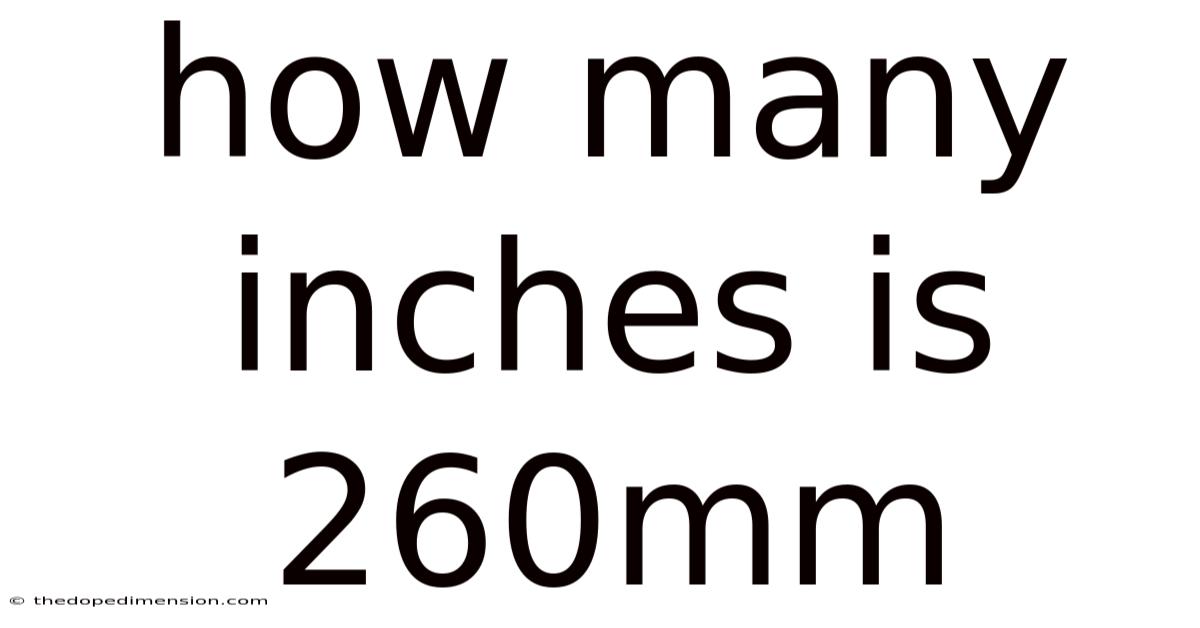How Many Inches Is 260mm
thedopedimension
Sep 07, 2025 · 4 min read

Table of Contents
How Many Inches is 260mm? A Comprehensive Guide to Metric-Imperial Conversion
Knowing how to convert between metric and imperial units is a crucial skill in many fields, from engineering and design to everyday cooking and crafting. This comprehensive guide will delve into the conversion of 260 millimeters (mm) to inches (in), explaining the process, the underlying mathematics, and providing helpful context to ensure a thorough understanding. We'll also explore common applications and address frequently asked questions to solidify your knowledge.
Introduction: Understanding the Metric and Imperial Systems
The world uses two primary systems of measurement: the metric system (also known as the International System of Units or SI) and the imperial system (primarily used in the United States and a few other countries). The metric system is based on multiples of 10, making conversions relatively straightforward. The imperial system, however, uses a less consistent system of units, often requiring more complex calculations. Understanding the differences is key to successful conversions.
The Conversion: 260mm to Inches
The fundamental conversion factor between millimeters and inches is:
- 1 inch = 25.4 millimeters
To convert 260mm to inches, we can use this ratio:
260 mm * (1 inch / 25.4 mm) = 10.236 inches (approximately)
Therefore, 260mm is approximately 10.24 inches.
Step-by-Step Calculation:
-
Identify the conversion factor: Remember that 1 inch equals 25.4 millimeters.
-
Set up the equation: We want to convert millimeters to inches, so we'll set up a fraction with inches in the numerator and millimeters in the denominator: (1 inch / 25.4 mm).
-
Multiply: Multiply the given value in millimeters (260 mm) by the conversion factor: 260 mm * (1 inch / 25.4 mm).
-
Simplify: The "mm" units cancel out, leaving us with the answer in inches: 260 / 25.4 inches ≈ 10.236 inches.
-
Round: Depending on the level of precision required, you can round the answer. For most practical purposes, rounding to two decimal places (10.24 inches) is sufficient.
Practical Applications of 260mm (Approximately 10.24 inches):
Understanding the equivalence of 260mm and 10.24 inches is useful in a variety of situations:
-
Engineering and Design: Converting measurements between metric and imperial systems is crucial in projects involving international collaboration or the use of components from different manufacturers. A precise understanding of 260mm's equivalent in inches ensures accurate design and manufacturing.
-
Construction and DIY: Many building materials and tools are labeled in both metric and imperial units. Being able to convert measurements accurately prevents errors and ensures projects are completed correctly. For example, knowing that a 260mm board is about 10.24 inches can be vital for proper cutting and fitting.
-
Photography and Videography: Lens focal lengths are often expressed in millimeters (in the metric system) while other equipment specs might be in inches. Converting between these units is essential for proper image composition and equipment compatibility.
-
Automotive Repair and Maintenance: Automotive components and specifications may be given in both metric and imperial units. Accurate conversions are necessary for appropriate part selection and repair procedures.
Further Exploration of Metric-Imperial Conversions:
While we focused on millimeters and inches, understanding the broader context of metric-imperial conversions is beneficial. Here's a brief overview of other common conversions:
-
Meters to Feet/Yards: One meter is approximately 3.28 feet or 1.09 yards.
-
Kilometers to Miles: One kilometer is approximately 0.62 miles.
-
Liters to Gallons: One liter is approximately 0.26 gallons.
-
Kilograms to Pounds: One kilogram is approximately 2.2 pounds.
Frequently Asked Questions (FAQs):
-
Q: Is the conversion of 260mm to inches always exactly 10.236 inches?
- A: No, the value of 10.236 inches is an approximation. The actual value has more decimal places. The level of precision required dictates the appropriate number of decimal places to use.
-
Q: Why is it important to use the correct conversion factor?
- A: Using an incorrect conversion factor leads to significant errors, especially in precise applications like engineering or construction. This can result in miscalculations, wasted materials, and even safety hazards.
-
Q: Are there online converters for metric-imperial units?
- A: Yes, many online converters are readily available. These tools can help with quick conversions, but it's still important to understand the underlying principles of conversion.
-
Q: What if I need to convert from inches to millimeters?
- A: You would simply reverse the conversion factor. To convert inches to millimeters, multiply the number of inches by 25.4 mm/inch.
-
Q: Are there any other units of length I should be aware of?
- A: Yes, there are many other units of length within both the metric and imperial systems, including centimeters, kilometers, feet, yards, and miles.
Conclusion: Mastering Metric-Imperial Conversions
Mastering the conversion between metric and imperial units is an essential skill that transcends many disciplines. Understanding the conversion of 260mm to approximately 10.24 inches is just one step in this journey. By understanding the underlying principles and practicing conversions, you’ll build confidence and accuracy in your work, whether you're an engineer, a DIY enthusiast, or simply someone who needs to confidently navigate the complexities of different measurement systems. Remember, accuracy and precision are paramount, so always double-check your work and choose the appropriate level of precision based on the context of your application. The ability to confidently convert units is a valuable asset in today's interconnected world.
Latest Posts
Latest Posts
-
How Far Is 3300 Feet
Sep 08, 2025
-
How Far Is 800 Km
Sep 08, 2025
-
Convert 45880 Ml To Liters
Sep 08, 2025
-
22000 Acres To Square Miles
Sep 08, 2025
-
What Is 100km In Miles
Sep 08, 2025
Related Post
Thank you for visiting our website which covers about How Many Inches Is 260mm . We hope the information provided has been useful to you. Feel free to contact us if you have any questions or need further assistance. See you next time and don't miss to bookmark.